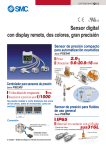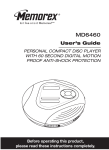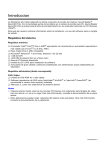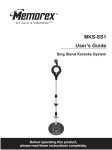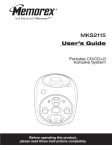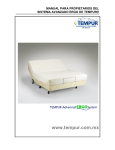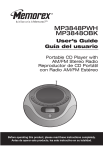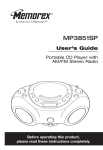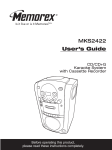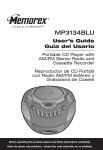Download Memorex MD6447 User's Manual
Transcript
MD6447 User’s Guide Guía del Usuario PERSONAL COMPACT DISC PLAYER WITH 60 SECONDS DIGITAL ANTISHOCK PROTECTION REPRODUCTOR DE DISCO COMPACTO PERSONAL CON PROTECCIÓN ANTISALTOS DIGITAL DE 60 SEGUNDOS Before operating this product, please read these instructions completely. Antes de operar este producto, sírvase leer este instructivo en su totalidad. SAFETY PRECAUTIONS CAUTION RISK OF ELECTRIC SHOCK DO NOT OPEN CAUTION: TO REDUCE THE RISK OF ELECTRIC SHOCK, DO NOT REMOVE COVER (OR BACK). NO USER-SERVICEABLE PARTS INSIDE. REFER SERVICING TO QUALIFIED SERVICE PERSONNEL. This Caution Marking is located at the bottom enclosure of the unit. DANGEROUS VOLTAGE: The lightning flash with arrowhead symbol within an equilateral triangle is intended to alert the user to the presence of uninsulated dangerous voltage within the product’s enclosure that may be of sufficient magnitude to constitute a risk of electric shock to persons. ATTENTION: The exclamation point within an equilateral triangle is intended to alert the user to the presence of important operating and maintenance (servicing) instructions in the literature accompanying the appliance. DANGER: This product utilizes a Class 1 laser to read Compact Discs. This laser Compact Disc Player is equipped with safety switches to avoid exposure when the CD door is open and the safety interlocks are defeated. Invisible and hazardous laser radiation when open and interlock failed or defeated. Avoid direct exposure to beam. Please do not attempt to defeat or bypass the safety switches. FCC WARNING: This equipment may generate or use radio frequency energy. Changes or modifications to this equipment may cause harmful interference unless the modifications are expressly approved in the instruction manual. The user could lose the authority to operate this equipment if an unauthorized change or modification is made. SURGE PROTECTORS: It is recommended to use a surge protector for AC connection. Lightning and power surges ARE NOT covered under warranty for this product. 1 SAFETY PRECAUTIONS • • • • • INFORMATION: This equipment has been tested and found to comply with the limits for a Class B digital device, pursuant to Part 15 of the FCC Rules. These limits are designed to provide reasonable protection against harmful interference in a residential installation. This equipment generates, uses and can radiate radio frequency energy and, if not installed and used in accordance with the instructions, may cause harmful interference to radio communications. However, there is no guarantee that interference will not occur in a particular installation. If this equipment does cause harmful interference to radio or television reception, which can be determined by turning the equipment off and on, the user is encouraged to try to correct the interference by one or more of the following measures: • Reorient or relocate the receiving antenna. • Increase the separation between the equipment and receiver. • Connect the equipment into an outlet on a circuit different from that to which the receiver is connected. • Consult the dealer or an experienced radio/TV technician for help. Do not open the CD compartment while the CD is rotating. Always keep the CD compartment closed when not in use. Keep all foreign objects out of the CD compartment. Place the unit on a stable surface. Avoid installing the unit in locations described below: • Places exposed to direct sunlight or close to heat radiating appliances such as electric heaters. • On top of other stereo equipment that radiates too much heat. • Places lacking ventilation or dusty places. • Places subject to constant vibration. • Humid or moist places. ATTENTION: POUR ÉVITER LES CHOC ÉLECTRIQUES, INTRODUIRE LA LAME LA PLUS LARGE DE LA FICHE DANS LA BORNE CORRESPONDANTE DE LA PRISES ET POUSSER JUSQU’AU FOND. This Class B digital apparatus complies with Canadian ICES-003. Cet appareil numérique de la classe B est conforme à la norme NMB-003 du Canada. 2 Dear Customer: Selecting fine audio equipment such as the unit you’ve just purchased is only the start of your musical enjoyment. Now it’s time to consider how you can maximize the fun and excitement your equipment offers. This manufacturer and the Electronic Industries Association’s Consumer Electronics Group want you to get the most out of your equipment by playing it at a safe level. One that lets the sound come through loud and clear without annoying blaring or distortion and, most importantly, without affecting your sensitive hearing. Sound can be deceiving. Over time your hearing “comfort level” adapts to higher volumes of sound. So what sounds “normal” can actually be loud and harmful to your hearing. Guard against this by setting your equipment at a safe level BEFORE your hearing adapts. To establish a safe level: • Start your volume control at a low setting. • Slowly increase the sound until you can hear it comfortably and clearly, and without distortion. Once you have established a comfortable sound level: • Set the dial and leave it there. Taking a minute to do this now will help to prevent hearing damage or loss in the future. After all, we want you listening for a lifetime. We Want You Listening For A Lifetime Used wisely, your new sound equipment will provide a lifetime of fun and enjoyment. Since hearing damage from loud noise is often undetectable until it is too late, this manufacturer and the Electronic Industries Association’s Consumer Electronics Group recommend you avoid prolonged exposure to excessive noise. This list of sound levels is included for your protection. Example Quiet library, soft whispers Living room, refrigerator, bedroom away from traffic Light traffic, normal conversation, quiet office Air conditioner at 20 feet, sewing machine Vacuum cleaner, hair dryer, noisy restaurant Average city traffic, garbage disposals, alarm clock at two feet NI C IND U EST. 1924 S N EIA S O O C I A TI IES 3 O TR Information courtesy of the Deafness Research Foundation. We Want You LISTENING For A Lifetime S Subway, motorcycle, truck traffic, lawn mower Garbage truck, chain saw, pneumatic drill Rock band concert in front of speakers, thunderclap Gunshot blast, jet engine Rocket launching pad A 90 100 120 140 180 R THE FOLLOWING NOISES CAN BE DANGEROUS UNDER CONSTANT EXPOSURE: ELECT Decibel Level 30 40 50 60 70 80 LOCATION OF CONTROLS 1. LINE OUT Jack (Rear of Unit) 2. PHONES (Headphones) Jack (Rear of Unit) 3. VOLUME Control (Rear of Unit) 4. DBBS (Bass Boost) Switch (Rear of Unit) 5. CD Door OPEN Switch 6. ESP Button 7. MODE Button 8. PROG (Program) Button 9. Skip/Search o Button 10. Display 11. HOLD (ON/OFF) Switch (Rear of Unit) 12. DC 4.5V Jack (Rear of Unit) 13. Battery Compartment (Under CD Compartment) 14. CD Compartment 15. PLAY/PAUSE (®p)/POWER ON Button 16. STOP (■)/POWER OFF Button 17. Skip/Search n Button z 4 POWER SOURCES This CD player requires either two (2) “AA” cell batteries (not included) or an AC adapter (not included). BATTERY INSTALLATION The battery indicator ( ) will appear in the CD display when the batteries need replacing. 1. Open the CD compartment, then open the – battery compartment door by pressing in on – + the tab and then lifting it. To prevent the possibility of losing the cover, it cannot be removed. 2. Insert two (2) “AA” cell batteries (not + –+ included) according to the polarity diagram inside the battery compartment. Alkaline batteries are recommended for the longest playing time. + – BATTERY PRECAUTIONS Follow these precautions when using batteries in this device: 1. Use only the size and type of batteries specified. 2. Be sure to follow the correct polarity when installing the batteries as indicated inside the battery compartment. Reversed batteries may cause damage to the device. 3. Do not mix different types of batteries together (e.g. Alkaline, Carbon-zinc or Rechargeable) or old batteries with fresh ones. 4. If the device is not to be used for a long period of time, remove the batteries to prevent damage or injury from possible battery leakage. 5. Do not try to recharge batteries not intended to be recharged; they can overheat and rupture. (Follow battery manufacturer’s directions.) AC OPERATION To operate the unit using AC power, connect an AC adapter (not included) to an AC outlet having 120V, 60Hz AC only. Plug the small end into the DC 4.5V jack on the unit and connect the other end into the AC outlet. The batteries are automatically disconnected when the AC adapter is used. CAUTION: When not using AC power, disconnect the AC adapter from the wall outlet by pulling the plug (not the cord). Do not touch the AC adapter with wet hands. Fully insert the plug without exposing any part of the blade. DC4.5V z 5 BASS BOOST 1 OPERATION TURNING POWER ON/OFF 1 2 To emphasize the bass, slide the DBBS switch to the ON position. For normal bass, slide the DBBS switch to the OFF position. HOLD SWITCH 1 To turn the unit on, press the PLAY/PAUSE (®p)/POWER ON button ❶. To turn the unit off, Press the STOP (■) /POWER OFF button ❷ while in the Stop mode. 1 1 Slide to the ON position to disable the buttons; “Hold” will appear in the display. Slide to the OFF position to enable the buttons. For the HOLD function, only the buttons will be disabled, not the other controls/switches (i.e., DBBS switch, VOLUME control, CD OPEN switch). AUTO POWER OFF When the unit is stopped (Standby mode) for approximately 30 seconds, the power will automatically turn off. 2 Audio System Radio Sound Through a Home By using a home audio connection cable (not included), superb radio sound can be heard through your home audio system. Before making any connections, turn off the power to all equipment. Plug a connection cable (not included) between the LINE OUT jack on the rear of the CD player and the amplifier’s AUX or CD input jack. (Do not connect it to the amplifier’s PHONO jack.) NOTE: If the radio interferes with TV reception, move the unit away from the TV or turn off the power to this unit. 6 CD OPERATION TO PLAY A CD (Standard, CD-R and CD-RW) 2 1 Press the PLAY/PAUSE (®p)/POWER ON button to turn the unit on; playback will start automatically. To pause PLAYBACK, press the PLAY/PAUSE (®p)/POWER ON button, the elapsed time will blink. Press once again to resume2playback. Open the CD compartment lid by sliding the CD OPEN switch to the right. Gently press a disc, label side up, onto the spindle until it locks in place. Close the CD compartment lid. Insert headphones into the PHONES jack. 3 4 2 1 2 3 4 Adjust the VOLUME control ❶ and DBBS switch ❷ as desired. To skip forward or backward through the tracks on the disc, press the SKIP/SEARCH o 3 or n 4 button. To search forward or backward through the tracks on the disc, press and hold the SKIP/SEARCH o 3 or n 4 button. When the disc is through playing, it will stop. Press the STOP (■)/POWER OFF button to stop the disc before it is finished; the total number of tracks will appear. Press the STOP (■)/POWER OFF button again while in the Stop mode to turn1 the unit off or wait approximately 30 seconds and the unit will automatically turn off. NOTES: • This unit is capable of playing standard CDs or 3” singles; no adapter is required. • If a disc is inserted incorrectly, dirty, damaged or not present at all, the display will show “disc”. • As each track is played, the track number and elapsed time are shown in the display. • To remove the disc, open the CD compartment, hold the edge of the CD, gently press the center pivot and lift the CD. • The maximum play time for a CD in this unit is 74 minutes. • “OPEN” will appear in the display when the CD door is open. 7 CD OPERATION (CONTINUED) 60 SECOND ELECTRONIC ANTI-SHOCK SYSTEM This CD player has a built-in Anti-Shock System that cuts down on CD skipping, which is useful when using the CD player in the car or while jogging/walking. Follow the steps below to activate and understand the Anti-Shock System: 1 2 Open the CD compartment lid by sliding the CD OPEN switch to the right. Gently press a disc, label side up, onto the spindle until it locks in place. Close the CD compartment lid. Insert headphones 2 into the PHONES jack. With a CD inserted, press the PLAY/PAUSE ( ®p )/POWER ON button to turn the unit on and start playback. The Anti-Shock System will start automatically, the sound will mute for a moment and the display will blink “ESP”. Within a few seconds, “ESP” will light solid to indicate music signals are stored in memory. If the CD player is subject to vibration during playback, “ESP” will blink again. During the vibration, the music should continue to play the signals stored in the memory until the CD player can read the music data properly from the disc. 2 4 3 CONTINUED ON THE NEXT PAGE 8 5 CD OPERATION (CONTINUED) 6 If no more vibration occurs, the music signals are once again stored into the memory and “ESP” will again light solid. When the memory is full, the disc rotation speed will drop to save power consumption. To turn the Anti-Shock System off, press the ESP button. To turn the Anti-Shock System on, press the ESP button again. 2 NOTES: • When the CD player is used in a stable location, turn the Anti-Shock System off by pressing the ESP button. When the Anti-Shock System is off, battery consumption is less. • The Anti-Shock System provides for continuous sound output when the unit is subject to vibration, but it will not correct errors, such as a defective or dirty CD. 9 CD OPERATION (CONTINUED) TO REPEATEDLY PLAY BACK ONE TRACK 2 1 2 3 4 2 3 1 1 With a CD inserted, press the PLAY/PAUSE (®p)/POWER ON button ❶ to turn the unit on, then select a track using the SKIP/SEARCH o 2 or n 3 button. Press the MODE button ❹ once; the Repeat 1 indicator 1 will appear in the display. The unit will then play the same track over and over until the STOP (■)/POWER OFF button ❶ is pressed. Adjust the VOLUME control ❷ and DBBS switch ❸ as desired. 1 2 ALL TO REPEATEDLY PLAY BACK ALL TRACKS 2 3 2 1 1 With a CD inserted, press the PLAY/PAUSE (®p)/POWER ON button ❶ to turn the unit on. Press the MODE button ❷ twice; the Repeat All ALL will appear in the indicator display. The unit will then play all the tracks on the CD over and over until the STOP (■)/POWER OFF button ❶ is pressed. Adjust the VOLUME control ❷ and DBBS switch ❸ as desired. TO CANCEL REPEAT PLAYBACK, press the MODE button four times if in Repeat 1 mode, or three times if in Repeat All mode. The unit will continue normal playback. 10 INTRO PLAY 1 CD OPERATION (CONTINUED) 2 2 3 3 2 1 4 With a CD inserted, press the PLAY/PAUSE ( )/POWER ON button ❶ to turn the unit on and press the STOP (■)/POWER OFF button ❷ to stop auto playback. Press the MODE button ❸ three times; the INTRO indicator will appear in the display. 1 Press the PLAY/PAUSE ( )/POWER ON button ❶ to begin playback. The unit will play the first 10 seconds of each track. Adjust the VOLUME control ❷ and DBBS switch ❸ as desired. Press the STOP (■)/POWER OFF button ❹ to stop Intro playback. TO CANCEL Intro Play, press the Mode button twice. TO RANDOMLY PLAY BACK A CD 1 2 2 3 3 2 1 4 With a CD inserted, press the PLAY/PAUSE ( )/POWER ON button ❶ to turn the unit on and press the STOP (■)/POWER OFF button ❷ to stop auto playback. Press the MODE button ❸ four times; the RAND indicator will appear in the display. 1 Press the PLAY/PAUSE ( )/POWER ON button ❶ to begin playback. The unit will play all the tracks in random order. Adjust the VOLUME control ❷ and DBBS switch ❸ as desired. When all the tracks have been played, the unit will stop. Press the STOP (■ )/POWER OFF button ❹ to stop Random playback. TO CANCEL Random Play, press the MODE button once. 11 CD OPERATION (CONTINUED) TO PROGRAM THE MEMORY (UP TO 20 TRACKS) 2 1 3 2 1 3 With a CD inserted, press the PLAY/PAUSE (®p)/POWER ON button 1 to turn the unit on and press the STOP (■)/POWER OFF button 2 to stop auto playback. Press the PROG button 3; the Track “00” and PROG indicator will blink. Also, the program “01” will appear in the display. 3 1 2 Select the first track to be played back using the SKIP/SEARCH o 1 or n ❷ button, then press the PROG button ❸ again. Repeat this step to program additional tracks up to a maximum of 20 tracks. 4 2 3 1 1 Press the PLAY/PAUSE ( ®p ) /POWER ON button ❶ to begin Programmed playback and adjust the VOLUME control ❷ and DBBS switch ❸ as desired. 2 To skip forward or backward through the programs, press the SKIP/ SEARCH o 1 or n ❷ button. When the disc is through playing, it will stop. NOTES: • Press the STOP (■)/POWER OFF button to stop the disc before it is finished. • Press the STOP (■)/POWER OFF button while in the Stop mode to turn the unit off and clear the Program memory. • As each program is played, the track number is shown in the display. • Programming is the ability to preselect the order in which a series of tracks will be played. • Each track may be stored in the program memory as many times as desired (up to 20 tracks). • To play the Program on Repeat, simply press the MODE button twice while playing the Program. 12 CARE AND MAINTENANCE Caring for Compact Discs • Treat the compact disc carefully. Handle the compact disc only by its edges. Never allow your fingers to come in contact with the shiny, unprinted side of the compact disc. • Do not attach adhesive tape, stickers, etc. to the compact disc label. • Clean the compact disc periodically with a soft, lint-free, dry cloth. Never use detergents or abrasive cleaners to clean the compact disc. If necessary, use a CD cleaning kit. • If a compact disc skips or gets stuck on a section of the disc, it is probably dirty or damaged (scratched). • When cleaning the compact disc, wipe in straight lines from the center of the compact disc to the outer edge of the compact disc. Never wipe in circular motions. • This unit is designed to play only compact discs bearing the identification logo as shown here. Other compact discs may not conform to the CD standard and may not play properly. • Compact discs should be stored in their cases after each use to avoid damage. • Do not expose compact discs to direct sunlight, high humidity, high temperatures or dust, etc. Prolonged exposure or extreme temperatures can warp the compact disc. • Do not stick or write anything on either side of the compact disc. Sharp writing instruments, or the ink, may damage the surface. Cleaning the Unit • To prevent fire or shock hazard, disconnect your unit from the AC power source when cleaning. • The finish on your unit may be cleaned with a dust cloth and cared for as other furniture. Use caution when cleaning and wiping the plastic parts. • Mild soap and a damp cloth may be used on the front panel. 13 TROUBLESHOOTING GUIDE If you experience a problem with this unit, check the chart below before calling for service. SYMPTOM Unit will not turn on. Disc will not play. Erratic CD playback. No sound from headphones. ESP not working. CAUSE Batteries inserted incorrectly. Weak or dead batteries. AC adapter not connected. CD compartment not closed. Disc inserted incorrectly. Dirty or defective disc. Moisture condensation on disc. Dirty or defective disc. Headphone plug not inserted correctly. VOLUME control set to minimum. Weak batteries. Defective disc. ESP is not activated. 14 SOLUTION Insert batteries correctly. Replace batteries. Check AC adapter connection. Close CD compartment. Reinsert disc correctly. Try another disc. Wipe disc with soft cloth. Clean or replace disc. Reinsert headphone plug correctly. Increase volume. Replace batteries. Try another disc. Press the ESP button. SPECIFICATIONS Power requirements......................................2 x LR6 "AA" alkaline battery DC In 4.5V adapter (center positive) D/A conversion ...................................1-bit DAC eight times oversampling Frequency response ............................................20~20,000Hz (+1,-3 dB) Anti-shock. .......................................................................60 second buffer Output level. ..........................................Line output: 0.6 Vms (47K ohms) Headphone: 16mW (32 ohms) FOR ADDITIONAL SET-UP OR OPERATING ASSISTANCE, PLEASE VISIT OUR WEBSITE AT WWW.MEMOREXELECTRONICS.COM OR CONTACT CUSTOMER SERVICE AT (954) 660-7100. PLEASE KEEP ALL PACKAGING MATERIAL FOR AT LEAST 90 DAYS IN CASE YOU NEED TO RETURN THIS PRODUCT TO YOUR PLACE OF PURCHASE OR MEMOREX. FOR PARTS AND ACCESSORIES, CONTACT FOX INTERNATIONAL AT 1-800-321-6993. 15 MEDIDAS DE SEGURIDAD CUIDADO RIESGO DE DESCARGA ELÉCTRICA. NO ABRIR. ADVERTENCIA: Para reducir el riesgo de descargas eléctricas no saque la cubierta o la tapa posterior. Allí no se encuentran partes que puedan ser reparadas por el usuario. Lleve su unidad a un Centro de Servicio Autorizado. Esta marca de alerta se encuentra en el fondo del gabinete de la unidad. ADVERTENCIA: La figura de la flecha con forma de rayo dentro de un triángulo está hecho para alertar al usuario de la presencia de cables sin aislar de "voltaje peligroso" dentro del gabinete, de tal magnitud que puede causar un riesgo de descarga eléctrica a las personas. ADVERTENCIA: El signo de exclamación dentro de un triángulo está hecho para alertar al usuario de la existencia de instrucciones importantes tanto de servicio como de funcionamiento y mantenimiento que vienen con la unidad. PELIGRO: Este producto utiliza un láser de Clase 1 para leer los discos compactos. Este reproductor de discos compactos con láser está equipado con interruptores de seguridad para evitar el contacto cuando la puerta del CD está abierta y el intercierre de seguridad está vencido. Radiación láser invisible y riesgosa cuando está abierto y el intercierre está averiado o vencido. Evite la exposición directa al haz de luz. No intente vencer o circunvalar los interruptores de seguridad. AVISO DE LA FCC: Este equipo genera o puede usar energía de frecuencia radial. Cualquier cambio o modificación al equipo, puede causar interferencia nociva, a menos que estas modificaciones esten expresamente indicadas en el manual de instrucciones. El usuario puede perder el derecho de operar este equipo si efectuara un cambio o modificación no autorizadas. PROTECTORES DE PICOS: Se recomienda utilizar un protector de picos para la conexión eléctrica. Los picos del relámpago y de la energía no se cubren en la garantía de este producto. 1 MEDIDAS DE SEGURIDAD • • • • • AVISO DE LA FCC: Este equipo genera o puede usar energía de frecuencia radial. Cualquier cambio o modificación al equipo, puede causar interferencia nociva, a menos que estas modificaciones esten expresamente indicadas en el manual de instrucciones. El usuario puede perder el derecho de operar este equipo si efectuara un cambio o modificación no autorizadas. Este sistema está de acuerdo con los límites exigidos por la Clase B para dispositivos electrónicos tal como se especifican en la Parte 15 del Reglamento FCC. Estos límites ofrecen una protección razonable contra la interferencia de radio o televisión, aún cuando esté operando correctamente. Para eliminar cualquier interferencia, usted puede intentar una o más de las siguientes medidas correctivas: • Re-oriente o cambie de posición la antena receptora. • Aumente la distancia existente entre el sistema y el radio o televisión. • Use distintos toma-corrientes para el radio o la televisión. • Si el problema subsiste, consulte a un técnico especializado en radio/televisión. No abra el compartimiento del CD mientras el CD esté girando. Siempre mantenga el compartimiento del CD cerrado cuando no se esté usando. No meta objetos extraños en el compartimiento del CD. Coloque la unidad sobre una superficie estable. Evite instalar la unidad en los lugares descritos a continuación: • Lugares expuestos a la luz directa del sol o cerca de aparatos que irradian calor como calentadores eléctricos. • Arriba de otros equipos estereofónicos que irradian demasia do calor. • Lugares con poca ventilación o polvorientos. • Lugares sujetos a una vibración constante. • Lugares húmedos. ATTENTION: POUR ÉVITER LES CHOC ÉLECTRIQUES, INTRODUIRE LA LAME LA PLUS LARGE DE LA FICHE DANS LA BORNE CORRESPONDANTE DE LA PRISES ET POUSSER JUSQU’AU FOND. Este aparato digital de Clase B cumple con la norma ICES-003 de Canadá. Cet appareil numérique de la classe B est conforme à la norme NMB-003 du Canada. 2 Estimado cliente: El haber seleccionado un equipo de tan alta tecnología, como el que usted acaba de comprar, es sólo el comienzo de su entretenimiento musical. Ahora es tiempo de tomar en consideración como optimizar el entretenimiento que su equipo le ofrece. Este fabricante y la Asociación de Industrias Electrónicas del Grupo de Consumidores Electrónicos desean que usted obtenga el mejor resultado de su equipo usándolo en un nivel seguro, tal como el escuchar el sonido claro y sonoro, sin distorsión - sobre todo sin que afecte su sentido auditivo. El sonido es engañoso, ya que con el tiempo su nivel de audición puede adaptarse solo a escuchar en volumen alto, resultando en un serio daño a su sentido auditivo. Protéjase contra este daño innecesario ajustando el volumen de su equipo a un nivel bajo antes de acostumbrarse a escuchar siempre la música a un volumen alto. Para establecer un nivel auditivo seguro: • Ponga el control de volumen en posición baja. • Lentamente aumente el nivel hasta que usted pueda escuchar clara y confortablemente sin distorsión. Una vez que establece el nivel de audición confortable: • Deje fijo el control de Volumen en dicho nivel. Esto solo le tomará un minuto, y le ayudará a prevenir la pérdida del oído en el futuro. Nosotros deseamos que usted pueda oir durante toda su vida Si sabe usar su equipo, éste le proveerá mucho tiempo de satisfacción y entretenimiento. Debido a que el daño causado al oido es imperceptible hasta que ya es muy tarde, este fabricante y la Asociación de Industrias Electrónicas le recomiendan evitar la exposición prolongada a ruidos excesivos. La lista que le damos a continuación le servirá de guía: Nivel de Decibeles 30 40 50 60 70 80 Ejemplo Una biblioteca, susurros. Sala, refrigeradora, dormitorio lejos del tráfico. Semáforo, conversación no rmal, oficina tranquila. Aire acondicionado a 20 pies, máquina de coser Aspiradora de polvo, secadora de pelo, restaurant bullicioso. Tráfico de la calle, destructores de basura,alarma de reloj a dos pies. LOS SIGUIENTES RUIDOS PUEDEN SER PELIGROSOS SI SE SOMETE A ELLOS EN FORMA CONSTANTE C IND U EIA EST. 1924 S S N ELECT R NI O O C I A TI IES 3 O A Esta información ha sido proporcionada gratuitamente por la Fundación de Investigación de la Sordera. We Want You LISTENING For A Lifetime TR Subterráneo, motocicletas, tráfico de camiones, podadora de pasto. Camión de basura, sierra eléctrica, perforadora neumática. Concierto rock delante de los parlante, ruido de truenos. Sonido de disparo, motor de jet. Lanzamiento de una nave espacial. S 90 100 120 140 180 UBICACIÓN DE LOS CONTROLES 1. Enchufe de SALIDA DE LÍNEA (atrás en la unidad) 2. Enchufe de AUDÍFONOS (atrás en la unidad) 3. Control de VOLUMEN (atrás en la unidad) 4. Interruptor de DBBS (incremento de bajos) (atrás en la unidad) 5. Botón para Abrir Puerta de CD 6. Botón ESP 7. Botón MODO 8. Botón PROG (Programa) 9. Botón Brincar/Buscar o 10. Pantalla 11. Interruptor de SOSTENER (encendido/apagado) (atrás de la unidad) 12. Enchufe DC 4.5V (atrás en la unidad) Compartimiento de pilas (abajo del compartimiento del CD) Compartimiento del CD Botón TOCAR/PAUSA (®p)/ENCENDIDO Botón PARO (■)/APAGADO z 13. 14. 15. 16. 17. Botón Brincar/Buscar n 4 FUENTES DE ENERGÍA Este reproductor de CD requiere dos (2) pilas de celda "AA" (no incluidas) o un adaptador de corriente alterna (no incluido). INSTALACIÓN DE PILAS El indicador de la pila ( ) aparecerá en la pantalla del CD cuando las pilas están bajas y necesita cambiarlas. 1. Abra el compartimiento del CD, luego abra la – –+ puerta del compartimiento de la pila haciendo presión en la lengüeta y levantándola. Para evitar la posibilidad de perder la tapa, ésta no puede quitarse. 2. Introduzca dos (2) pilas de celda "AA" (no + –+ incluidas) de acuerdo al diagrama de polaridad dentro del compartimiento de la pila. Se recomienda el uso de pilas alcalinas para una mayor duración. + – CUIDADO DE LAS PILAS Cuando use pilas tome las siguientes precauciones: 1. Use únicamente el tamaño de pila que indica el fabricante. 2. Asegúrese de seguir la polaridad indicada en el compartimiento cuando instale su pila. De no hacerlo, usted puede dañar su unidad. 3. No mezcle tipos de pila diferentes, por ejemplo alcalinas, con Carbono de Cinc, así como tampoco debe mezclar pilas usadas con nuevas. 4. Si no va a usar su unidad por un largo período de tiempo, saque la pila para evitar que vaya a oxidarse y dañar las terminales. 5. Nunca intente recargar pilas que no han sido hechas para este fín, ya que pueden recalentarse y explotar. (Siga las instrucciones del fabricante de las pilas). OPERACIÓN CON CORRIENTE ELÉCTRICA Para operar la unidad usando corriente eléctrica, conecte un adaptador de corriente alterna (no incluido) a un contacto eléctrico de 120V AC, 60Hz. Enchufe el extremo angosto en el enchufe de 4.5V en un lado de la unidad y conecte el otro extremo en el contacto eléctrico. Las pilas se desconectan automáticamente al usar el adaptador. PRECAUCIÓN: Cuando no use energía eléctrica, desconecte el adaptador del contacto eléctrico jalando del enchufe (pero no del cable). No toque el adaptador con las manos mojadas. Introduzca la clavija por completo sin que quede expuesta parte de la clavija. DC4.5V z 5 OPERACIÓN INCREMENTO DE BAJOS 1 ENCENDIDO/APAGADO 1 2 1 Para encender la unidad, presione el botón TOCAR/PAUSA (®p)/ ENCENDIDO 1. Para apagar la unidad, presione el botón PARO (■)/APAGADO 2. Para enfatizar los bajos, deslice el interruptor de DBBS a la posición ON (encendido). Para los bajos normales, deslice el interruptor de DBBS a la posición OFF (apagado). 1 INTERRUPTOR DE SOSTENER 1 Deslícelo a la posición ON (encendido) para deshabilitar los botones; "Hold" (sostener) aparecerá en la pantalla. Deslícelo a la posición OFF (apagado) para habilitar los botones. En la función SOSTENER, solamente se deshabilitarán los botones, no los demás controles e interruptores (por ejemplo, el interruptor de DBBS, el control de VOLUMEN, el botón para abrir puerta de CD). AUTO APAGADO Cuando se detiene la unidad (en modo de "Standby") aproximadamente por 30 segundos, la unidad se apagará automáticamente. 2 DE AUDIO EN EL HOGAR REPRODUCCIÓN POR SISTEMA Con un cable de conexión, se puede escuchar el magnífico sonido del CD mediante su sistema de audio en el hogar. Antes de hacer cualquier conexión, apague todo el equipo. Conecte un cable de conexión (no incluido) entre el enchufe de LÍNEA DE SALIDA por el lado del reproductor de CD y el enchufe de entrada al CD o AUX del amplificador. (No lo conecte en el enchufe PHONO del amplificador). NOTA: Si el reproductor de CD interfiere con la recepción de TV o radio, aleje el reproductor de CD de la TV o radio o apague el reproductor de CD. 6 OPERACIÓN DEL CD REPRODUCIR UN CD (Estándar, CD-R y CD-RW) 2 1 Presione el botón TOCAR/PAUSA (®p)/ ENCENDIDO para encender la unidad; la reproducción empezará automáticamente. Para poner la reproducción en pausa, presione de nuevo el botón TOCAR/PAUSA ( ®p)/APAGADO y parpadeará el tiempo transcurrido. Presione una vez más para reanudar 2 la reproducción. Abra la tapa del compartimiento del CD deslizando el botón para abrir puerta de CD a la derecha. Presione suavemente un disco sobre el eje, con la etiqueta hacia arriba, hasta que quede fijo en su lugar. Cierre la tapa del compartimiento del CD. Inserte los audífonos en el enchufe para AUDÍFONOS. 3 4 2 1 2 3 4 Ajuste el control de VOLUMEN 1 y el interruptor DBBS 2 según desee. Para brincar hacia la siguiente pista o a la anterior en el disco, oprima el botón BRINCAR/BUSCAR O 3 o N 4. Para brincar hacia adelante o atrás en una misma pista en el disco, oprima y mantenga oprimido el botón de BRINCAR/BUSCAR O 3 o N 4. Cuando el disco termine de tocar, se detendrá. Presione el botón PARO (■ )/APAGADO para detener el disco antes de terminar; aparecerá el número total de pistas. Para apagar la unidad, presione de nuevo el botón PARO 1 mientras está en modo de (■)/APAGADO Paro o espere unos 30 segundos y la unidad se apagará automáticamente. NOTAS: • Esta unidad puede tocar discos de tamaño normal o sencillos de 3"; no se requiere adaptador. • Si el disco se inserta incorrectamente, o está sucio, dañado o no hay ninguno presente, la pantalla mostrará "disco". • A medida que se toca cada pista, se muestra en la pantalla el número de pista y el tiempo transcurrido. • Para quitar el disco, abra el compartimiento del CD, luego sostenga la orilla del CD y oprima suavemente el pivote del centro y levante el CD. • El tiempo máximo de un CD es 74 minutos para esta unidad. • "OPEN" (abierto) aparecerá en la pantalla cuando la puerta del CD esté abierta. 7 OPERACIÓN DEL CD (CONTINÚA) SISTEMA ANTI-SALTOS ELECTRÓNICO DE 60 SEGUNDOS Este reproductor de CD tiene integrado un sistema anti-saltos que elimina los saltos en el CD, lo cual es útil cuando se usa el reproductor en el automóvil o mientras trota o corre. Siga los pasos a continuación para activar y entender el sistema anti-saltos: 1 2 Abra la tapa del compartimiento del CD deslizando el botón para abrir puerta de CD a la derecha. Presione suavemente un disco sobre el eje, con la etiqueta hacia arriba, hasta que quede fijo en su lugar. Cierre la tapa del compartimiento 2 del CD. Inserte los audífonos en el enchufe para AUDÍFONOS. Después de introducir un disco, presione el botón TOCAR/PAUSA (®p)/ENCENDIDO para encender la unidad y empezar la reproducción. El sistema anti-saltos se activará automáticamente, el sonido se pondrá en silencio por un momento y la pantalla parpadeará con las letras "ESP". Después de unos segundos, las letras "ESP" se iluminarán sin parpadear indicando que las señales de música están almacenadas en la memoria. Si el reproductor de CD se somete a vibraciones durante la reproducción, las letras "ESP" parpadearán de nuevo. Durante la vibración, la música debe continuar tocando las señales en la memoria hasta que el reproductor de CD pueda leer adecuadamente del disco con la información de la música. 2 4 3 CONTINÚA EN LA PRÓXIMA PÁGINA 8 5 OPERACIÓN DEL CD (CONTINÚA) 6 Si no ocurren más vibraciones, las señales de música se almacenan de nuevo en la memoria y las letras "ESP" se iluminarán de nuevo sin parpadear. Cuando la memoria esté llena, disminuirá la velocidad de rotación del disco para ahorrar energía. Para apagar el sistema anti-saltos, presione el botón ESP. Para encender el sistema anti-saltos, presione de nuevo el botón ESP. 2 NOTAS: • Cuando el reproductor de CD se usa en un lugar estable, apague el sistema anti-saltos presionando el botón ESP. Cuando el sistema anti-saltos está apagado, se reduce el consumo de la pila. • El sistema anti-saltos brinda una salida continua de sonido cuando se somete la unidad a vibraciones, pero no corregirá errores, como los de un disco defectuoso o sucio. 9 OPERACIÓN DEL CD (CONTINÚA) TOCAR REPETIDAMENTE UNA MISMA PISTA 2 1 2 3 4 2 3 1 1 Con un CD introducido, presione el botón TOCAR/PAUSA (®p)/ENCENDIDO 1 para encender la unidad y luego seleccione una pista utilizando el botón BRINCAR/BUSCAR O 2 o N 3. Oprima una vez el botón MODO 4; en la pantalla aparecerá el indicador de Repetir . La unidad tocará entonces la misma pista una y otra vez hasta que presione el botón PARO (■ )/APAGADO 1 . Ajuste el control de VOLUMEN 2 y el interruptor de DBBS 3 según desee. 1 2 TOCAR REPETIDAMENTE TODAS LAS PISTAS 2 3 2 1 1 Con un CD introducido, presione el botón TOCAR/PAUSA (®p)/ ENCENDIDO 1 para encender la unidad. Presione dos veces el botón MODO 2; en la pantalla aparecerá el (repetir indicador de Repeat All todas). La unidad tocará entonces todas las pistas en el CD una y otra vez hasta que presione el botón PARO (■)/APAGADO 1. Ajuste el control de VOLUMEN 2 y el interruptor de DBBS 3 según desee. PARA CANCELAR LA REPRODUCCIÓN REPETIDA, presione cuatro veces el botón MODO si está en modo de Repetir 1, o tres veces si está en modo de Repetir todas. La unidad continuará con la reproducción normal. 10 OPERACIÓN DEL CD (CONTINÚA) TOCAR LA INTRODUCCIÓN 1 2 2 3 3 2 1 4 Con un CD introducido, presione el botón TOCAR/PAUSA (®p)/ENCENDIDO 1 para encender la unidad y luego presione el botón PARO (■)/APAGADO 2 para detener la reproducción automática. Presione tres veces el botón MODO 3; en la pantalla aparecerá el indicador INTRO. 1 Presione el botón TOCAR/PAUSA (®p)/ENCENDIDO 1 para empezar la reproducción. La unidad reproducirá los primeros 10 segundos de cada pista. Ajuste el control de VOLUMEN 2 y el interruptor de DBBS 3 , según desee. Presione el botón PARO ( ■ )/APAGADO 4 para detener la reproducción de la introducción. PARA CANCELAR la reproducción de la introducción, presione dos veces el botón Modo. REPRODUCIR UN CD EN MODO ALEATORIO 1 2 2 3 3 2 1 4 Con un CD introducido, presione el botón TOCAR/PAUSA (®p)/ ENCENDIDO 1 para encender la unidad y luego presione el botón PARO (■)/APAGADO 2 para detener la reproducción automática. Presione cuatro veces el botón MODO 3; en la pantalla aparecerá el indicador RANDOM (aleatorio). 1 Presione el botón TOCAR/PAUSA (®p)/ENCENDIDO 1 para empezar la reproducción. La unidad reproducirá todas las pistas en orden aleatorio. Ajuste el control de VOLUMEN 2 y el interruptor de DBBS 3, según desee. Cuando se terminen de reproducir todas las pistas, la unidad se detendrá. Presione el botón PARO (■)/APAGADO 4 para detener la reproducción aleatoria. PARA CANCELAR la reproducción aleatoria, presione una vez el botón Modo. 11 OPERACIÓN DEL CD (CONTINÚA) PROGRAMAR LA MEMORIA (HASTA 20 PISTAS) 2 1 3 2 1 3 Con un disco introducido, presione el botón TOCAR/PAUSA (®p)/ENCENDIDO 1 para encender la unidad y presione el botón PARO ( ■ )/APAGADO 2 para detener la reproducción automática. Presione el botón PROG 3; la pista "00" y el indicador de PROG parpadearán. Asimismo, aparecerá el programa "01" en la pantalla. 3 1 2 Seleccione la primera pista a tocar usando el botón BRINCAR/BUSCAR o 1 o n ❷, y luego presione de nuevo el botón PROG ❸. Repita este paso para programar todas las pistas deseadas hasta un máximo de 20 pistas. 4 2 3 1 1 Presione el botón TOCAR/PAUSA (®p) /ENCENDIDO 1 para iniciar la reproducción programada y ajuste los controles de VOLUMEN 2 y el interruptor de DBBS 3, según desee. 2 Para saltar hacia adelante o atrás por los programas, presione el botón Brincar/Buscar o 1 o n ❷. Cuando el disco termine de tocar, se detendrá. NOTAS: • Presione el botón PARO (■)/APAGADO para detener el disco antes de terminar. • Presione el botón PARO (■)/APAGADO mientras está en modo de Paro para apagar la unidad y borrar la memoria del programa. • A medida que se toque cada programa, se mostrará el número de pista en la pantalla. • Programar es la habilidad de seleccionar previamente el orden en el cual se reproducirá una serie de pistas. • Cada pista puede guardarse en la memoria del programa tantas veces como desee (hasta 20 pistas). • Para reproducir el programa repetidas veces, simplemente presione dos veces el botón MODO mientras se reproduce el programa. 12 CUIDADO Y MANTENIMIENTO Cuidado a los discos compactos • Trate el disco con cuidado. Maneje el disco sólo por sus orillas. Nunca permita que sus dedos toquen el lado brilloso y sin impresión del disco. • No pegue cinta adhesiva, calcomanías, etc. sobre la etiqueta del disco compacto. • Limpie el disco compacto periódicamente con una tela suave, seca y sin pelusas. Nunca use detergentes ni limpiadores abrasivos para limpiar el disco. Si es necesario, use un juego de limpieza para CD. • Si el disco salta o se atora en una sección del disco, probablemente esté sucio o dañado (rayado). • Cuando limpie el disco, frote en línea recta del centro hacia la orilla exterior del disco compacto. Nunca frote con movimientos circulares. • Esta unidad fue diseñada sólo para tocar discos compactos que lleven el logotipo que se muestra aquí. Es posible que otros discos no cumplan con la norma de CD y no se escuchen bien. • Los discos compactos deben guardarse en sus cajas después de usarlos para evitar daños. • No exponga los discos compactos a los rayos directos del sol, mucha humedad, altas temperaturas o polvo, etc. La exposición prolongada o las temperaturas extremas puede doblar el disco compacto. • No pegue ni escriba nada sobre ninguno de los lados del disco compacto. Los instrumentos filosos o bien la tinta pueden dañar la superficie. Limpieza de la unidad • Para prevenir los riesgos de incendio o choque eléctrico, desconecte su unidad de la fuente de AC cuando la esté limpiando. • El acabado de su unidad puede limpiarse con un trapo seco como cuidaría cualquier otro mueble. Tenga cuidado al limpiar y restregar las partes de plástico. • Puede usar un jabón neutro y un trapo húmedo para limpiar el panel frontal. 13 GUÍA DE DIAGNÓSTICO Si experimenta problemas con esta unidad, revise la tabla a continuación antes de llamar a servicio. SÍNTOMA La unidad no enciende. Disco no toca. Reproducción de CD errática. No hay sonido en audífonos. ESP no funciona. CAUSA Pilas introducidas incorrectamente. Pilas bajas o vacías. Adaptador AC no conectado. Compartimiento del CD abierto. Disco introducido incorrectamente. Disco sucio o defectuoso. Condensación en el disco. Disco sucio o defectuoso. Calvija de audífonos no insertada correctamente. Control de VOLUMEN en mínimo. Disco defectuoso. ESP no está activado. 14 SOLUCIÓN Introduzca las pilas correctamente. Cambie las pilas. Revise la conexión del adaptador AC. Cierre el compartimiento del CD. Introduzca el disco correctamente. Pruebe con otro disco. Frote el disco con un trapo suave. Limpie o cambie el disco. Reinserte la clavija correctamente. Suba el volumen. Pruebe con otro disco. Presione el botón ESP. ESPECIFICACIONES Requisitos de energía ..........................2 pilas alcalinas LR6 tamaño "AA" .................Adaptador DC de 4.5V (centro positivo) Conversión D/A......................... Sobremuestreo de 8 veces DAC de 1 bit Respuesta de Frecuencia ..................................20~20,000 Hz (+1,-3 dB) Anti-salto. .........................................Memoria intermedia de 60 segundos Nivel de salida...............................Salida de línea: 0.6 Vms (47K ohmios) ...................................................................Audífonos: 16mW (32 ohmios) PARA OBTENER AYUDA ADICIONAL CON RESPECTO A LOS AJUSTES O A LA OPERACIÓN, SÍRVASE VISITAR NUESTRO SITIO WEB EN WWW.MEMOREXELECTRONICS.COM O COMUNÍQUESE CON SERVICIO AL CLIENTE AL (954) 660-7100. SÍRVASE GUARDAR LOS MATERIALES DEL EMPAQUE AL MENOS DURANTE 90 DÍAS POR SI ACASO NECESITARA REGRESAR EL PRODUCTO A SU DISTRIBUIDOR O A MEMOREX. PARA OBTENER PARTES Y ACCESORIOS, COMUNÍQUESE CON FOX INTERNATIONAL AL 1-800-321-6993. 15 Memcorp, Inc. Weston, FL Printed in Hong Kong Visit our website at www.memorexelectronics.com Memcorp, Inc. Weston, FL Impreso en Hong Kong Visite nuestro sitio web en www.memorexelectronics.com
This document in other languages
- español: Memorex MD6447
































